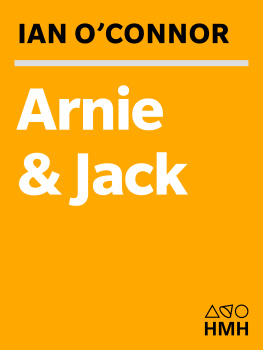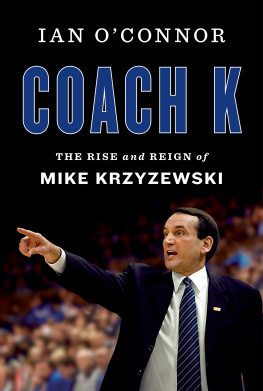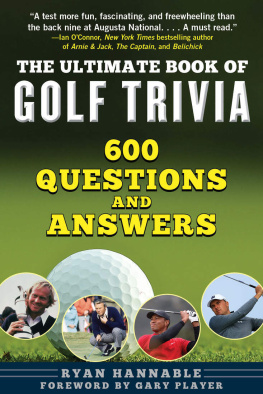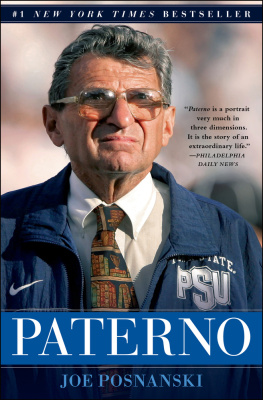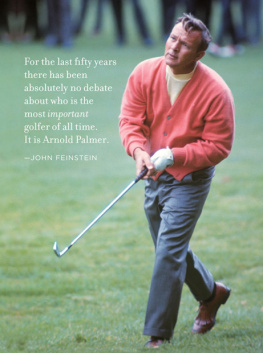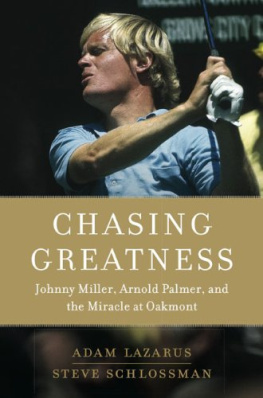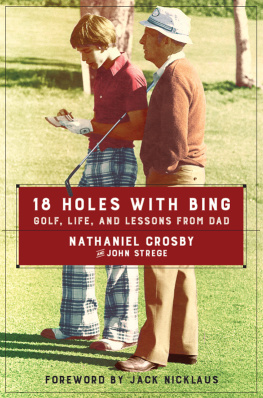Copyright 2008 by Ian OConnor
ALL RIGHTS RESERVED
For information about permission to reproduce selections from this book, write to or to Permissions, Houghton Mifflin Harcourt Publishing Company, 3 Park Avenue, 19th Floor, New York, New York 10016.
www.hmhco.com
The Library of Congress has cataloged the print edition as follows:
OConnor, Ian.
Arnie & Jack : Palmer, Nicklaus, and golfs greatest rivalry / Ian OConnor.
p. cm.
Includes bibliographical references and index.
ISBN -13: 978-0-618-75446-5
1. Palmer, Arnold, date. 2. Nicklaus, Jack. 3. GolfersUnited States Biography. I. Title.
GV 964. A 1026 2008
796.352092'2dc22
[ B ] 2007052330
e ISBN 978-0-547-34739-4
v6.0718
To Kyle,
my best friend and all-time favorite golf partner.
Youre living proof that angels walk the earth.
To Tracey,
my forever love and inspiration.
Youre the heroine who makes every word worth
writing and every breath worth taking.
Introduction
T IGER WOODS , billionaire-to-be, had just run the tip of a three-dollar pen across his seventy-dollar slacks. He was the only player in the locker room at the Doral resort in Miami, and he was inspecting his ink stain the way he would an eight-foot putt.
Shit, he said. These pants are done.
I extended my hand and explained the purpose of my intrusion, and Woods kindly agreed to hear me out. I was wondering if Tiger felt cheated by the players who were pursuing him. I was wondering if he wished he had what Jack Nicklaus had in Arnold Palmer, and what Arnie had in Jack.
His omnipresent Nike cap tucked low over his brow, Woods measured the thought for a moment and loosed that killer smile of his. No, he said.
He went on to talk about the greater depth of talent on todays PGA Tour and about the players he considered worthy major championship challengersthe Phil Mickelsons and Vijay Singhs. Woods made it clear he was far more interested in winning than in the substance and style of the opponents he vanquished in the process.
No, Tiger didnt need any defining rival. He needed only a fair-and-square chance to break Nicklauss record of eighteen major titles, the target hed famously posted on his childhood walls.
Woods stands at thirteen at the start of the 2008 season, and none of his contemporaries expected to compete in the Masters has won more than three. Mickelson is the closest thing to a true Tiger rival, and the heat that radiates between them is marketable and real.
But Woods-Mickelson didnt unfold when television was a burgeoning phenomenon in search of live passion-play programming; Palmer-Nicklaus did. Arnie and Jack represented the perfect conflict in personality, background, and style at the perfect timejust as TV was starting to plant larger-than-life figures in Americas living rooms and dens.
By the time Tiger and Phil came along, golf fans were well aware of what an intense rivalry meant to a sport. Arnie and Jack had taught them well.
They made for simple good guy-versus-bad guy stuff, the kind that attracted drama-starved viewers and the network executives and advertisers forever trying to reach them. Palmer was the protagonist and Nicklaus the antagonist, and they needed each other on a golf course the way any sheriff and outlaw needed each other for a gunfight.
Arnie was the first man to prove a golfer could be an athlete, a TV star, and a sex symbol rolled into one. Jack was the first man to prove Ben Hogan would not go down as the greatest player of all time.
Palmer and Nicklaus battled each other across five decades and never staged the kind of near-brawl experience Mickelson and Singh shared inside Augusta Nationals champions locker room in 2005, when Phil and Vijay went nose to nose over the spike marks Mickelson allegedly left on the twelfth green. Arnie and Jack were too smart for that.
But without ever throwing a punch, without ever spilling a single drop of each others blood, Palmer and Nicklaus went after each other with the same snot-busting fury that defined the clashes between Muhammad Ali and Joe Frazier.
Only there was something about Palmer that Nicklaus could never lay a glove on. Arnold had something well below his skin that attracted people to him, said Frank Chirkinian, the longtime producer of Masters telecasts on CBS. He looked like the type of fellow you could walk up to and say, Lets have a beer, and he would.
Arnie had the fans and wanted the trophies; Jack had the trophies and wanted the fans. In the struggle permanent scars were left on each side.
Six years ago one of Arnies granddaughters would hear from a kindergarten classmate that Jack Nicklaus is more of a legend than Arnold Palmer. But to this day Jack hears and feels a vastly different sentiment from vocal galleries.
I still get hurt [by Palmers fans], you know, Nicklaus said, and I know how to live with it because I expect it. We can play the Skins Game in Hawaii and I still get it. I just accept it. Its not me. You learn that its not you. Its Arnold. Nobodys going to replace Arnold from that standpoint with the public.
When told that Nicklaus admitted he could still get hurt by Arnies Army, Palmer said of the man who defeated him on the golf course more often than not: You can only be so many things in your life.
In other words, Arnies brother Jerry said, there can only be one Arnold Palmer.
To recapture the flaming spirit of golfs greatest rivalry, I conducted extensive interviews with Nicklaus and Palmer, the most fascinating one taking place at forty-seven thousand feet, somewhere between Calgary and Palm Beach on Nicklauss spacious Gulfstream V. Jack talked right through the four-course meal served by his wife, Barbara. He talked for five hours and couldve gone for five more.
So much ground to cover; so many lessons to share. Nicklaus and Palmer have lived incredibly rich and profound lives. They stand as American icons chiseled into golfs Mount Rushmore, giants who arent even six feet tall.
Johnny Miller, the golfer and broadcaster, would say that playing with Palmer in the early seventies was definitely tougher than playing with Tiger today. He said a two-round pairing with Arnie and his rambunctious gallery was like a four-shot penalty.
Gary Player, third member of the Big Three, would say that a thirty-year-old Nicklaus wouldve beaten a thirty-year-old Woods if both had equal access to golfs nuclear-powered technology.
If you gave Jack that equipment, Player said, I think Jack wouldve been better.
In the end Woods will have more trophies than Jack and more fans than Arnie. But long before golf produced a prospective billionaire named Tiger, two lions fought like hell for control of an evolving and exploding sport.
In the course of researching and writing this book, I was often asked some variation of this question: Who do you think won the battle, Arnold Palmer or Jack Nicklaus?
My answer was always the same: It depends on how you keep score.
Prologue
Athens
T HE ELDERS AT the Athens Country Club had cobbled together a big day to honor one of their own, Dow Finsterwald, and needed to fill the last slot on their VIP list. They wanted a man and settled for a boy instead.
Fred Swearingen, club president, had been struck by a sudden thought. He would call up this hot-shot kid in Columbus and ask him if he would care to play eighteen holes of golf with Finsterwald, the brand-new winner of the PGA Championship, and Dows good friend Arnold Palmer, brand-new winner of the Masters.
Swearingen found a listing for Charlie Nicklauss drugstore. Charlie answered the phone.
Is your boy interested in playing with the PGA champ and the Masters champ? Swearingen asked.

